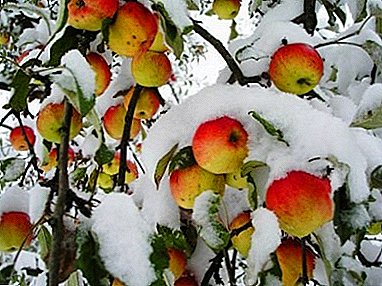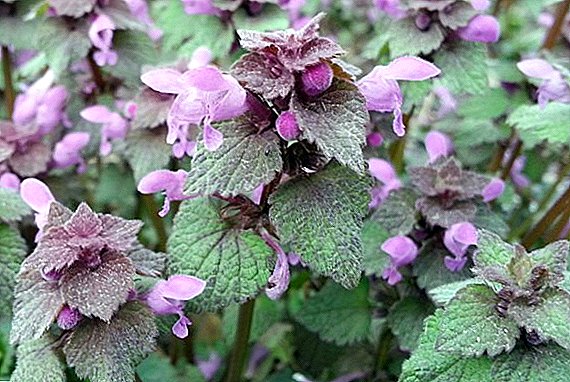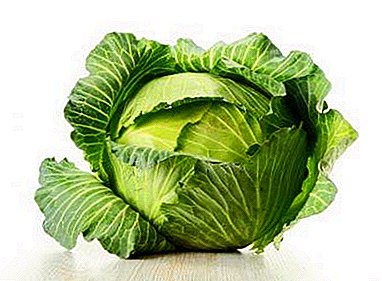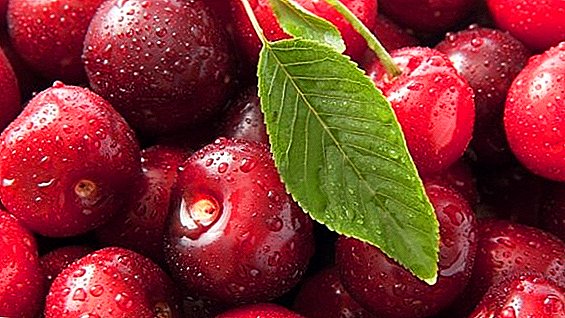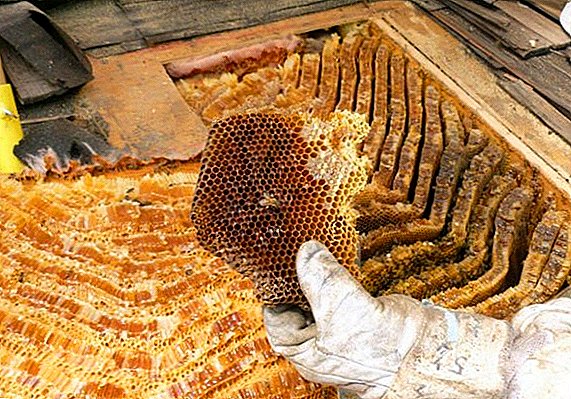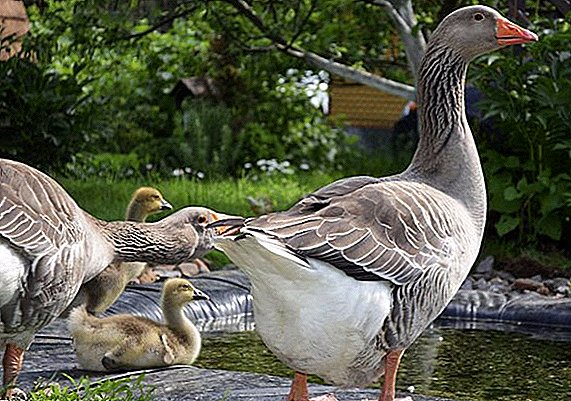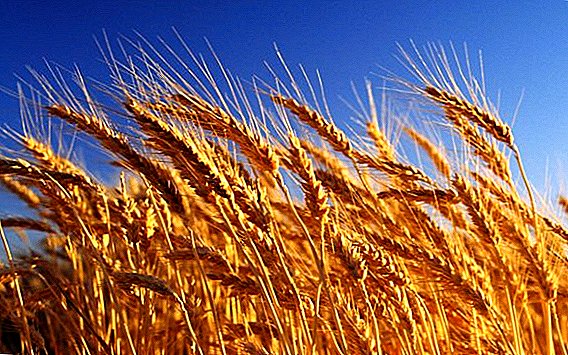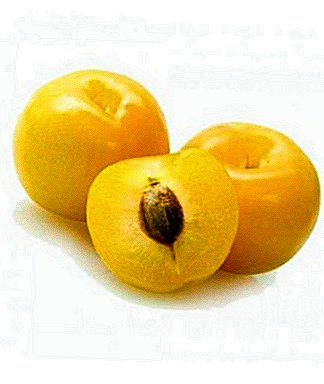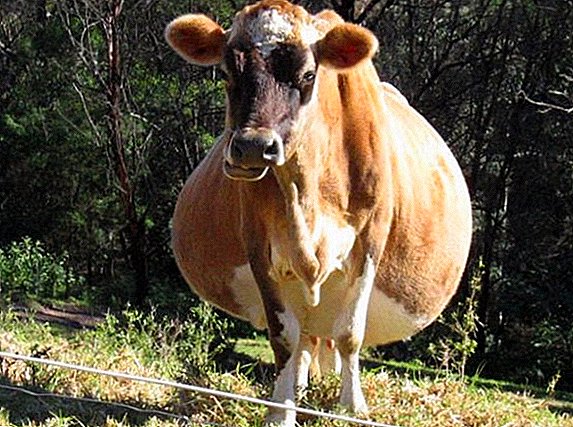 A good result of breeding cow herds is a stable receipt of one calf from each cow annually. Sometimes this result doubles, and the cow brings twins. But, unfortunately, this creates more problems than profits.
A good result of breeding cow herds is a stable receipt of one calf from each cow annually. Sometimes this result doubles, and the cow brings twins. But, unfortunately, this creates more problems than profits.
Let's look at how you can determine that a cow has a double pregnancy, and how a person can help an animal during calving.
Can a cow give birth to twins
Double pregnancy in cows is rare, it makes up from 2 to 4 percent of the total livestock. Although rare, this happens, and a cow and newborn calves require double care. Getting two calves from one calving is clearly advantageous, since the cow herd is expanding faster.
However, this is not the best way to increase livestock, as double pregnancy is often associated with certain complications, starting with difficult births and ending with problems with the health of the cow. Studies show that a high milk yield affects the onset of double ovulation.
Did you know? In the Indian state of Madhya Pradesh, the harshest laws for the protection of Hindu sacred animals. Any person convicted of killing a cow will be sentenced to prison for up to seven years.
The percentage of double ovulation in highly productive cows was determined at about 20%. Also hormonal treatment of cows infertility, which sometimes leads to fertilization of more than one egg, can also contribute to the emergence of double pregnancy.
Pregnancy is a huge burden for the cow. And two developing fetuses need a significant amount of calcium to form skeletons, which can create a deficiency of this element in the mother's body and, as a result, lead to postpartum paralysis. Often this can be accompanied by retention of the placenta, as well as inflammation of the uterus.  Often, with multiple pregnancies, complications occur. This is most often associated with improper placement of the fruit. Both fetuses can simultaneously try to go through the birth canal of a cow. In this situation, veterinary intervention is usually required.
Often, with multiple pregnancies, complications occur. This is most often associated with improper placement of the fruit. Both fetuses can simultaneously try to go through the birth canal of a cow. In this situation, veterinary intervention is usually required.
Did you know? The world's most expensive cow was sold in 2009 for $ 1.2 million at the Royal Agricultural Winter Fair in the UK.
How to determine that a cow will have twins
Twenty years ago, a veterinarian could only give an opinion on the pregnancy of a twin cow after carrying out transrectal palpation or directly at calving. The method of transrectal palpation gave a low accuracy of recognition of multiple pregnancy in cattle, below 50% of the number of all examinations.
In modern farms, pregnant cows are used for ultrasound diagnostics using an ultrasound examination device (USG). This procedure is most conveniently carried out with a gestation period of 6.5-8 weeks.  At this time, the belly of a pregnant cow is not too big, the veterinarian is easy to draw around with his hand, he is available for scanning at different angles and in a different plane. At this time, the embryos are already quite large, their length is from 2.7 to 5 cm, they are easy to observe with the help of ultrasound.
At this time, the belly of a pregnant cow is not too big, the veterinarian is easy to draw around with his hand, he is available for scanning at different angles and in a different plane. At this time, the embryos are already quite large, their length is from 2.7 to 5 cm, they are easy to observe with the help of ultrasound.
How twins are born in cows
If a cattle breeder suspects (or knows for sure, through ultrasound) that his cow is pregnant with twins, he should provide additional attention and care for the animal: regular prenatal walking, good nutrition and, possibly, assistance at calving.
Read more about how many days the cow bears a calf and how to keep the baby on the chop, and also find out what to do after calving.
Signs of approach
Characteristic signs of the approaching birth of a cow:
- an empty udder swells a few days before delivery, it becomes more pink;
- when pressed from the nipple appears thick and sticky colostrum;
- udder nipples look slightly swollen;
- vaginal mucus activity increases - thick transparent mucus from the vulva leaks;
- vulvar swollen and red;
- 1-2 days before calving, cruciate ligaments (depressions near the base of the tail) relax;
- the abdomen is released below, the ribs are distinguished by clear arches;
- animals become restless, often lie down, get up, utter a low;
- there is a frequent supply of small portions of urine and feces;
- the animal raises the base of the tail for a few minutes.
How to take delivery
Childbirth begins with the onset of labor. From this point on, calving can last from half an hour to three hours. If the position of the fruit is normal and the labor activity is clearly visible, the cow does not need help. The breeder should not interfere in the generic process prematurely, but you need to be close to help if necessary.
Important! Attempts to extend the calf by the legs, as soon as they appear in the perineum, can lead to the fact that the baby will be crippled or the cow will have a rupture of the perineum or the prolapse of the uterus.
Assistance during the calving of twins
If the breeder does not observe alarming symptoms in the woman in labor, you must wait patiently until the legs of the calf appear. After that, the intrauterine position of calves is checked and, if necessary, the vagina is smeared with gel. It is important to remain calm during calving, not to make sudden jerks, do not shout, do not panic.  During the beginning of the calving, two fetuses are located in the mother's uterus so that one calf goes to the exit from the birth canal with the muzzle and the front legs, and the other with the rear legs. The situation is usually when one calf is born above the second.
During the beginning of the calving, two fetuses are located in the mother's uterus so that one calf goes to the exit from the birth canal with the muzzle and the front legs, and the other with the rear legs. The situation is usually when one calf is born above the second.
A person who provides care inserts a hand into the birth canal and determines where the legs of the upper fetus are. If everything is in order, the breeder takes the half-born calf and slowly pulls it out. Immediately help to be born, gently and carefully pulling, the upper calf. When giving birth to the first calf, another baby should be gently pushed back into the uterine cavity of the cow.
Important! During obstetric care, it is important not to confuse the legs of two calves. Before you start pulling the calf by the legs, you need to be sure that they belong to the same newborn.
After the appearance of calves into the light, they clear the airways, if the animals do not breathe, they do chest massage and artificial ventilation of the lungs. If the birth was difficult, sometimes calves need to be supported upside down. It helps them get rid of mucus in the airways.  A few hours after calving, the cow is usually milked. And leave next to the calves for two days, then milf joins the herd. At this time, they look after her - if she eats well, and if there is no fever.
A few hours after calving, the cow is usually milked. And leave next to the calves for two days, then milf joins the herd. At this time, they look after her - if she eats well, and if there is no fever.
What is the interval between calves
The first baby of a cow is born one or two hours before the birth of the second. In between childbirth mothers watered. After the second birth, the animal is watered (if managed to collect) with its amniotic fluid left after the birth.
Amniotic waters are rich in hormones and serve as a stimulant for a painless and easy exit of the placenta (afterbirth). If the amniotic fluid was not collected, then the animal is fed with warm, slightly salted water in the amount of 40-60 liters.
How many follow a cow when double
Pregnancy twins in a cow can be dvuyaytsevoy and identical. Twin twins are the result of simultaneous or sequential fertilization of 2 eggs. Moreover, each fetus develops separately and has its own individual placenta (afterbirth).
Find out what to do if the cow does not leave the last or she has eaten it.
With identical twins, embryos develop simultaneously in one common placenta. Therefore, the number of outgoing after the calving depends on what was the pregnancy (identical or dvuayaytsevoy).  If the afterbirth does not come out on its own, it is necessary to resort to medical stimulation or to remove the placenta manually. These procedures should be done only by a specialist, therefore, in this case, invite a veterinarian.
If the afterbirth does not come out on its own, it is necessary to resort to medical stimulation or to remove the placenta manually. These procedures should be done only by a specialist, therefore, in this case, invite a veterinarian.
Important! Cows, like many other animals, are prone to eating the placenta after childbirth. It is important not to allow this, since the animal will have an upset gastrointestinal tract. If, however, this happened, you need to keep the cow without food for 24 hours, just give water to drink and wait until the placenta comes out naturally.
Features of the development of same-sex and opposite-sex twins
Veterinarians claim that about half of the born twins are made up of a bull and calf. A little girl born in such a pair should not be left on the tribe, since it will carry defective genes.
Freemartinism is recognized as one of the most severe forms of sexual anomalies among cattle, it causes infertility in most cows. When the hen divides the uterus with a bull for two, the placental membranes connecting the fetuses to the umbilical cord are separated.
The combination of placental membranes occurs from the 40th day of pregnancy, after which the fluids of the two embryos are mixed. This causes an exchange of blood and antigens that carry characteristics unique to each heifer and bull.  When these antigens mix, they affect each other in such a way that each of them develops with certain characteristics of the other sex. Although this rarely reduces fertility in a male twin, in more than 90% of cases, the twin female becomes completely barren.
When these antigens mix, they affect each other in such a way that each of them develops with certain characteristics of the other sex. Although this rarely reduces fertility in a male twin, in more than 90% of cases, the twin female becomes completely barren.
Did you know? In 2009, scientists investigated the bull genome and found that cattle have about 22,000 genes, of which 80 percent are identical to human genes.
Transmission of hormones or cells can lead to a serious underdevelopment of the female twin's reproductive tract, and sometimes even contain some elements of the bull's reproductive tract. That is, freemartin is genetically female, but it has many masculine characteristics.
Freemartin ovaries do not develop properly and usually remain in an embryonic state. The external genitals of the little chicks can be both normal and partially similar to bovine.
Freemartinism cannot be prevented. However, it can be diagnosed in several ways, ranging from a simple examination of the placental membranes to chromosomal assessment. If only two bulls or two calves were born in twins - these will be normal animals that can leave behind a full-fledged offspring. 
How to feed twins if there is not enough milk
Not later than one hour after birth, babies are sent to the mother, who licks them and lets them to the udder. In addition, each calf sucks up to one and a half liters of colostrum. The first days after birth, the cow feeds babies 5-6 times a day.
We recommend reading about how to feed the calves correctly, what vitamins to give them, and also find out what to do if the calf is sluggish and does not eat well.
Calves are born without immunity against disease. Until they develop their ability to resist disease, they are completely dependent on passive immunity acquired with maternal colostrum. Colostrum is a very thick, creamy yellow milk, enhanced by blood proteins and vitamins, the first after calving.
The colostrum contains the antibodies necessary to pass on the mother's immunity to the babies, and the level of protein and electrolytes is elevated. If the babies lack mother's colostrum, and subsequently milk, the same products are quite suitable for them, but taken from other healthy cows.  Toddlers are fed both fresh colostrum and pre-frozen colostrum is heated to +37 ° C. It is impossible to feed the calves with colostrum for a long time, because on the fourth day after calving, it abruptly loses its nutritional value. In large farms procure this product for future use, by the method of freezing.
Toddlers are fed both fresh colostrum and pre-frozen colostrum is heated to +37 ° C. It is impossible to feed the calves with colostrum for a long time, because on the fourth day after calving, it abruptly loses its nutritional value. In large farms procure this product for future use, by the method of freezing.
Did you know? Cows have an excellent sense of smell and can smell at a distance of up to 9 kilometers.Childbirth is a critical moment that affects both the health of the mother and the health of the twins. Much depends on the conditions in which calving takes place, because during birth, microbes can enter the body through the nipples and the birth canal. Calves are also exposed to many hazards during this period. Therefore, the preparation of a cow for childbirth is very important and must begin a few weeks before calving.


